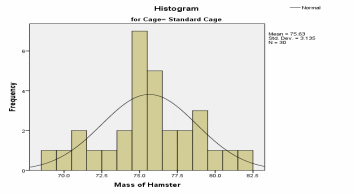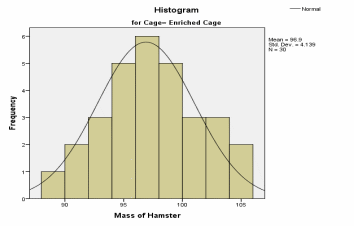Introduction
The cage microenvironment has significant effects on the growth and development of mice. Given that mice are animal models that researchers use in undertaking diverse research, they require appropriate husbandry (Pritchett-Corning, Chang, and Festing 494). Standard cage and enriched cage are two types of cages that are applicable in rearing mice for research purposes (Toth et al. 318). The standard cage allows mice to drink water and eat provided food, while enriched cage allows mice to not only eat and drink, but also play, make nests, climb structures, chew wood, run through cardboard tubes, and burrow sawdust (Bechard, Meagher, and Mason 173).
In this view, it is evident that standard cage and enriched cage have different microenvironments, which influence the growth and development of mice. Sztainberg and Chen state that the type of cage influences the physiological mechanisms and behavioral attributes of mice (1537). The statement implies that researchers need to consider cage microenvironment as a confounding variable of controlled experiments involving mice. The experiment hypothesized that mice kept in enriched cages are heavier than the ones kept in standard cages. In this view, the report describes an experiment to determine the influence of the cage microenvironment on the growth of mice.
Methods and Materials
The materials of the experiment are two standard cages (30cm by 30cm), two enriched cages (30cm by 30cm), hamster feed, water, and weighting balance. As an experimental methodology, we obtained 60 hamsters from the research center, which weighed around 50g each. Since cages have the capacity to hold 15 hamsters, we randomly placed 15 hamsters on each of the four cages, two standard cages, and two enriched cages. We then labeled hamsters placed on standard cages from 1 to 30 and the remaining hamsters placed on enriched cages labeled from 31 to 60. We fed the hamsters for a period of one month, and thereafter, we measured their masses using a weighing balance and recorded them on the sheet. We entered the data into the SPSS and then analyzed using descriptive statistics and paired t-test.
Results
Descriptive Statistics
Table 1 is a table of descriptive statistics, which indicates the distribution of hamsters between two groups, namely, standard cage (n = 30) and enriched cage (n = 30). Moreover, the descriptive statistics show that the mean mass of hamsters kept in an enriched cage is higher (M = 96.90±4.139) than the mean age of hamsters kept in standard cages (M = 75.63±3.135).
Table 1
Histograms
Unpaired t-test requires that the dependent variable should have no significant outliers and follow a normal distribution. To determine if data in each group follow a normal distribution, the study used histograms to depict the pattern of distribution in relation to the normal curve. The masses of hamsters in both standard cage and enriched cage, as shown in figures 1 and 2 respectively, show that there are no significant outliers and the data follow a normal distribution.


Unpaired T-Test
Table 2 is an unpaired t-test, which indicates t-value, significance value, and degrees of freedom, where the assumption of the equality of variances holds.
Table 2
The unpaired t-test indicates that hamsters kept in enriched cages are significantly heavier (M = 96.90±4.139) than hamsters kept in standard cages, t(58) = 22.4, p = 0.000.
Discussion
Descriptive statistics show that the mean mass of hamsters kept in enriched cages is higher (M = 96.90±4.139) than the mean mass of hamsters kept in standard cages (M = 75.63±3.135). Analysis of the apparent difference in mean masses using unpaired t-test supports the hypothesis that hamsters kept in enriched cages are heavier than the ones kept in standard cages, t(58) = 22.4, p = 0.000. Rosenbaum, VandeWoude, and Johnson argue that the microenvironment influences the growth of mice in cages (770). Researchers should consider the effects of the microenvironment on laboratory rodents because they influence physiological and metabolic mechanisms (Martin et al. 6130).
The consideration is important because the microenvironment confounds outcomes and reduces the validity of findings. Recent studies hold that enrichment of cages not only improves the welfare of mice, but also the validity of research findings (Abou-Ismail, Darwish, and Ramada 575; Abou-Ismail and Mahboub 148). Therefore, enriched cages enable researchers to enhance the validity of their research findings on mice or rodents.
Summary
Cage has a significant influence on the growth of mice because it alters the behaviors and physiological mechanisms of mice. Researchers usually use standard cages or enriched cages in rearing mice without regard for the effects of the microenvironment. The findings of this experiment support the hypothesis that mice kept in enriched cages are heavier than mice kept in standard cages, t(58) = 22.4, p = 0.000. In this view, the findings support the use of enriched cages in keeping mice for research purposes because they eliminate physiological and behavioral factors, which confound research outcomes.
Works Cited
Abou-Ismail, Usama, and Hamada Mahboub. “The effects of enriching laboratory cages using various physical structures on multiple measures of welfare in singly-housed rats.” Laboratory Animals 45.3 (2011): 145-153. Print.
Abou-Ismail, Usama, Ragab Darwish, and Sameh Ramada. “Should Cages of Laboratory Rats Be Enriched Physically or Social.” Global Veterinaria 13.4 (2014): 570-582. Print.
Bechard, Allison, Rebecca Meagher, and Georgia Mason. “Environmental Enrichment Reduces the Likelihood of Alopecia in Adult C57BL/6J Mice.” Journal of American Association for Laboratory Animal Science 50.2 (2011): 171-174. Print.
Martin, Bronwen, Sunggoan Ji, Stuart Maudsley, and Mark Mattson. “Control laboratory rodents are metabolically morbid: Why it matters.” Proceedings of the National Academy Science 107.14 (2010): 6127-6133. Print.
Pritchett-Corning, Kathleen, Fon Chang, and Michael Festing. “Breeding and housing laboratory rats and mice in the same room does not affect the growth or reproductive of either species.” Journal of American Association for Laboratory Animal Science 48.5 (2009): 492-498. Print.
Rosenbaum, Matthew, Susan VandeWoude, and Thomas Johnson. “Effects of cage-change frequency and bedding volume on mice and their microenvironment.” Journal of the American Association for Laboratory Animal Science 48.6 (2009): 763-773. Print.
Sztainberg, Yehezkel, and Alon Chen. “An environmental enrichment model for mice.” Nature Protocols 5.1 (2010): 1535-1539. Print.
Toth, Linda, Kevin Kregel, Lisa Leon, and Tomothy Musch. “Environment enrichment of laboratory rodents: The answer depends on the question.” Comparative Medicine 61.4 (2011): 314-321. Print.

